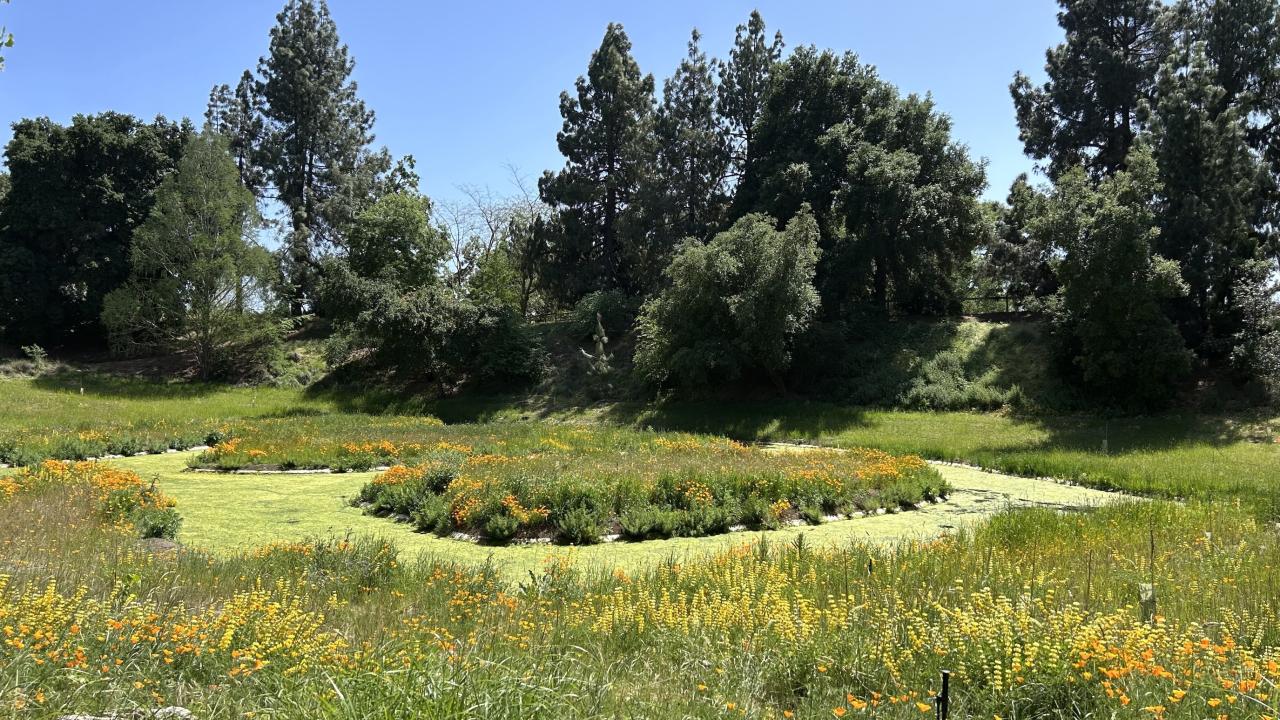
What’s Up with the Algae?
A Natural Step in the Arboretum Waterway’s Habitat Enhancement
If you’ve visited the UC Davis Arboretum recently, you might have noticed an algae bloom at the west end of the newly renovated Waterway. While algae can sometimes seem like a sign that something is wrong, Arboretum and Public Garden staff want visitors to know: this is actually a normal—and expected—part of a healthy wetland’s development.
"This is our first summer after the Waterway’s renovation, and we’re in an important phase of observing and fine-tuning how the system is developing," said Nina Suzuki, UC Davis Arboretum and Public Garden waterway steward. "While increased water flow has improved clarity and reduced algae growth across most of the Waterway, areas like the west end—with slower flow, shallow depths, and more solar exposure—are naturally prone to periodic blooms."
The Arboretum Waterway Flood Protection and Habitat Enhancement project shifted the landscape dramatically—from a concrete-lined channel to a more naturalized vegetated wetland with earthen banks. In this new setting, seeing algae isn’t just normal—it’s what you would expect in a thriving marsh.

"We’ve changed the context: before, algae growing against a stark concrete background looked out of place," said Suzuki. "Now, as we establish native wetland vegetation and riparian trees, algae will naturally be part of a healthier, more natural wetland ecosystem."
Interestingly, Suzuki noted that the type of algae now present is different from what once dominated the Arboretum Waterway. Previously, the Waterway experienced blooms of cyanobacteria, a type of algae that can sometimes produce toxins harmful to people and pets. In contrast, the current bloom is made up of non-toxic filamentous algae—a natural part of many wetland environments.
"Seeing this shift to a non-toxic, filamentous algae is another sign that the Waterway is moving in a healthier direction," Suzuki said. "It’s another example of how the ecosystem is changing for the better."
Although the Waterway still has nutrient-rich water and intense Central Valley sunlight—both factors that promote algae growth—it is designed as a living system that will change over time. Staff expect that in future years, as newly planted trees grow and begin shading the water, and as wetland plants like tules and rushes absorb excess nutrients, algae blooms will become less frequent.
"It’s part of a natural progression," Suzuki explained. "We’re seeing an initial flush of algae because of all the sunlight and nutrients available. Over time, with more vegetation, the system will balance out."
In fact, the slower flow at the west end was intentional. The design creates a wetland backwater environment where occasional algae blooms, along with other wetland processes, are part of supporting diverse plant and animal life. A marsh at the west end was always part of the vision for the Waterway restoration, and that will become even more apparent as the tules and rushes continue to grow and fill in, creating a more defined and dynamic wetland habitat.
Rather than trying to eliminate algae, staff are focusing their efforts on strengthening the newly planted habitat and educating visitors about how wetlands work.
"This gives us a real opportunity to teach about how wetlands function and why they look the way they do," said Suzuki. "We’re in a learning mode right now, observing how the new system operates, and we’re excited to see how the landscape continues to mature."
Visitors are encouraged to visit the Arboretum Waterway this spring to experience the vibrant wildflower bloom and to see firsthand how the new habitat is developing into a thriving, resilient ecosystem.
